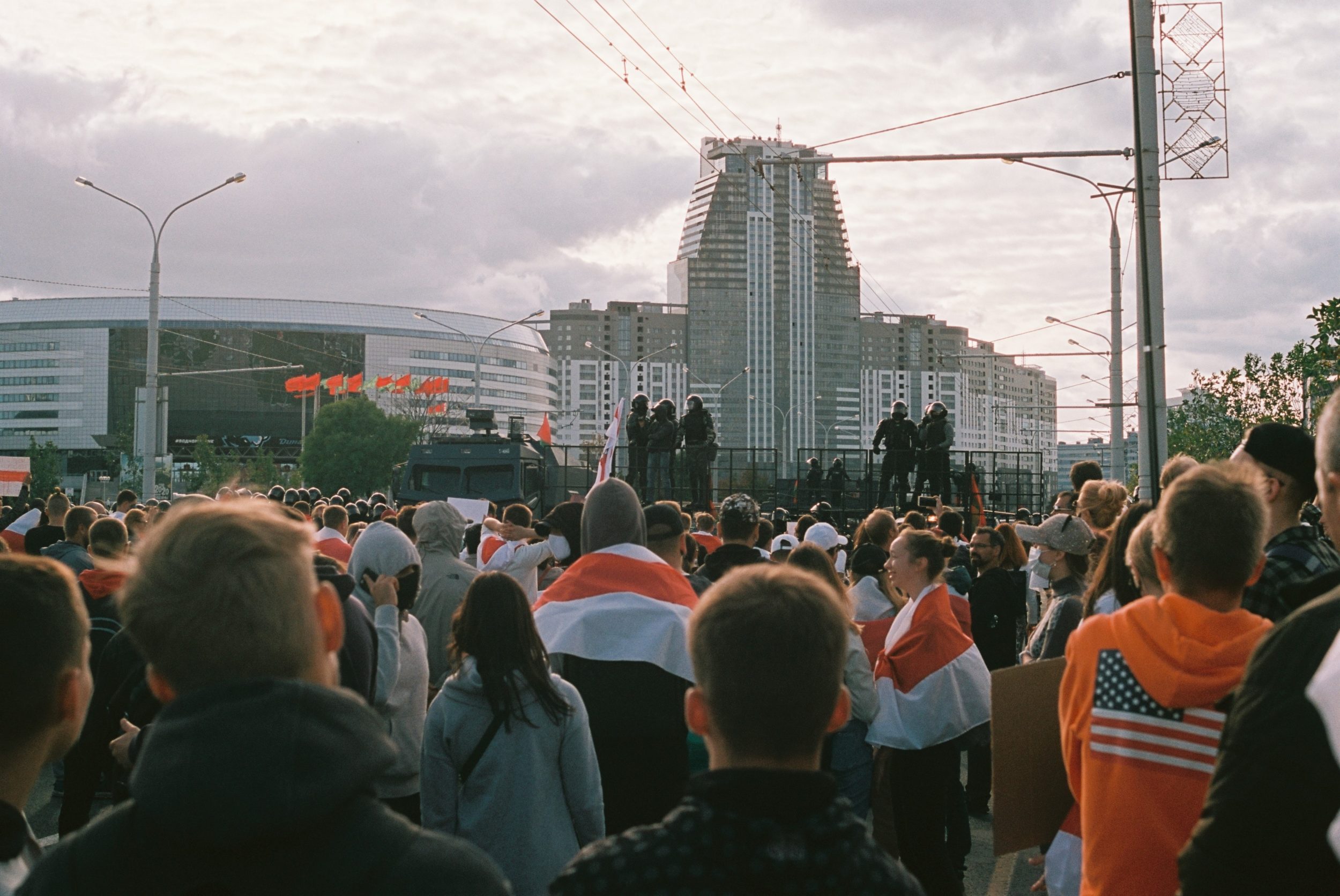
Following the 2020 presidential election results in favor of Lukashenko, Belarusians move to the streets demanding free and fair elections and democracy. However, this resulted in increasing state repression, police violence, and deeper authoritarianism. Belarus remained as “the last dictatorship in Europe“
Since they became independent from Soviet Russia, Belarusian political history has known only one leader. Lukashenko has been ruling the country since 1994. In the 2020 presidential elections, Tsikhanouskaya united the opposition and Belarusians went to the ballot boxes with the hope to end the rule of Lukashenko continuing for decades with harsh political repression. However, the aftermath of the elections ended the hopes to change the presidential office via systemic tools like voting. The victory of Lukashenko with a very high vote share of 80% resulted in a burst of mass movement in Belarus.
Opposition Candidate Tsikhanouskaya
Sviatlana Tsikhanouskaya was a strong figure before and after the election period. She was an educator and she has nominated for the candidacy after his husband Sergei Tsikhnousky has been arrested. Sergei Tsikhanousky was an activist working for the democratization of Belarus and criticizing the years-long rule of Lukashenko. He was arrested after he makes a statement about his intention to run as a candidate for the 2020 elections. Despite his arrest, his pursuit to challenge Lukashenko continued with Sviatlana Tsikhanouskaya. Tsikhanouskaya’s determinism and strong and brave stance created energy among people and trigger them to mobilize to demand free and fair elections against the decision of an authoritarian rule which does not even need to veil the election fraud. However, the movement did not succeed to change the presidency and may start the democratic transition in Belarus. Tsikhanouskaya fled the country.
Government Response
The mass movement was at first in the form of protests, marches, and rallies. The government responded to protestors with coercive repressions. Police violence directed towards protestors could be seen in the streets, and also for the arrested ones behind the walls. According to the reports of Human Rights Watch Belarusian police used excessive force, rubber bullets, stun grenades, tear gas, and blank ammunition to repress the protestors. Also according to the reports of Amnesty International, there are lots of people atrociously beaten by the police. In the meantime the government declared Lukashenko’s new term of presidency turning a blind eye to all of the dissent outbreaking in the society.
Despite the police violence, arrestments, and torture the protests kept going. Because mass protests were directly responded with coercion, people continue with individual defiance, local marches, and neighborhood organizations.
The aftermath of Protests, End of the Hopes?
2020 election protests show that Lukashenko’s regime has so strong that can endure ordinary and extraordinary means of change. After the protests, there are dozens of political prisoners and many more detained started to live in increased repression and surveillance. Lots of Belarusian seek political asylum, especially from Lithuania and one of them is the former candidate of the 2020 elections, Tsikhanouskaya. The political arrestments of Lukashenko government even exceed Belarus’ borders. They make arrestments via abroad operations. The killings of Belarusian activists living outside Belarus are very suspicious. Belarus is today among the least free countries with 8 points score on Freedom House’s 100 points scale. Its score decreased by 3 points compared to last year. After the Lukashenko government’s violent attempts to suppress the protests and its turn to deeper repression, the European Union and the countries like the UK, Canada, and US put sanctions on Belarus. For instance, some of the EU sanctions include sanctions preventing the trade of certain goods and access to capital markets. However, these attempts, even though they are intended to push Lukashenko to improve the political situation in favor of society’s demands, make life harder for Belarusian citizens than for the government.
So, the future does not look so bright for Belarus. What is even worse than all of the repressions, torture, and arrestments that a mobilization of that extent and duration, the protests continued for approximately a year, could not be sufficient to prevail the Lukashenko’s authoritarian rule. Is there any hope for Belarus? We will see what will happen in the future.
References
Amnesty International – Stand Wit Belarus https://www.amnesty.org/en/latest/campaigns/2021/01/stand-with-belarus/
Euronews – Revolt, repression and reprisals: A look back at a year of turmoil in Belarus https://www.euronews.com/2021/08/09/revolt-repression-and-reprisals-a-look-back-at-a-year-of-turmoil-in-belarus
Freedom House – Freedom in the world: Belarus https://freedomhouse.org/country/belarus/freedom-world/2022
Human Rights Watch – Belarus: Unprecedented Crackdown https://www.hrw.org/news/2021/01/13/belarus-unprecedented-crackdown
The Conversation – Belarus protests: why people have been taking to the streets – new data: https://theconversation.com/belarus-protests-why-people-have-been-taking-to-the-streets-new-data-154494

I like how this post very efficiently draws the line from fraudulent elections to protests and then to repression. Understanding how the cycle of protest and repression works is extremely important, as oftentimes the cycle escalates to a civil war. From my perspective, it seems like a civil war would be the only way for the Belarusian people to improve their situation. The regime has been in power so long, and has shown unwillingness to make any attempts at reforms. Also, the regime is likely to remain in power as it receives support from Russia. My question is this: Do you see the situation to Belarus escalating to a civil war? Or do you think that the regime will make reforms before that happens?
This article makes me interested delves into the Belarus political situation.
Your blog post offers valuable insights on Belarus’ post-2020 presidential election political landscape. It excels in clarity and structure, ensuring readers can easily follow events and their context. The introduction effectively engages readers by highlighting the key issue. You provide ample supporting detail and evidence, referencing respected organizations like Human Rights Watch and Amnesty International. Your balanced perspective acknowledges both opposition determination and the regime’s strength. While generally well-constructed, minor grammatical issues need attention for smoother readability. Your conclusion effectively summarizes the current Belarus situation, conveying ongoing challenges. Consider incorporating visuals and better formatting for enhanced readability. Overall, your post delivers a comprehensive view of Belarus’s complex political scene.